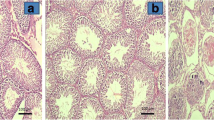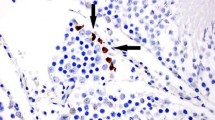Abstract
Recent evidence suggests that enhanced cell apoptosis is responsible for germ cell loss following testicular ischemia-reperfusion (IR) injury. A nonsteroidal anti-inflammatory drug diclofenac sodium (Voltaren) is a prostaglandin-synthesis inhibitor, which is widely used in many testicular disorders. The purpose of the present study was to examine the effect of diclofenac (DIC) on germ cell apoptosis in the ischemic and contralateral testes following testicular IR in a rat. Forty rats were divided randomly into four experimental groups of ten rats each: group A (Sham)—Sham operated animals; group B (Sham-DIC)—Sham operated rats that were treated with DIC given subcutaneously at a dose of 10 mg/kg, once daily, 24, 48 and 72 h following operation; group C (IR) underwent 90 min of unilateral testicular IR; group D (IR-DIC)—rats underwent 90 min of unilateral testicular IR and were treated with DIC similarly to group B. Ninety-six hours following operation, the rats were sacrificed and testes were harvested. Johnsen’s criteria and the number of germinal cell layers were used to categorize the spermatogenesis. TUNEL assay was used to determine germ cell apoptosis in both the ischemic and contralateral testes. Statistical analysis was performed using the non-parametric Kruskal–Wallis ANOVA test, with P less than 0.05 considered statistically significant. Testicular ischemia in rats led to histological damage in the ipsilateral testis. In the contralateral testis, minimal damage was observed. Germ cell apoptosis in both the ischemic and the contralateral testes increased significantly after IR. Treatment with DIC did not change histologic parameters of spermatogenesis in both the ischemic and contralateral testes, but decreased germ cell apoptosis in both testes following testicular IR. We conclude that testicular ischemia causes an increase in germ cell apoptosis in the contralateral testis. Diclofenac may be beneficial for spermatogenesis following testicular IR by decreasing germ cell apoptosis.

Similar content being viewed by others
References
Baccetti B, Collodel G, Piomboni P (1996) Apoptosis in human ejaculated sperm cells (notulae seminologicae 9). Submicrosc Cytol Pathol 28:587–596
Bartke A (1995) Apoptosis of male germ cells, a generalized or cell type-specific phenomenon. Endocrinology 136:3–4
Bartsch G, Frank S, Marberger H, Mikuz G (1980) Testicular torsion: late results with special regard to fertility and endocrine function. J Urol 124:375–378
Cheuk BL, Chew SB, Fiscus RR, Wong PY (2002) Cyclooxygenase-2 regulates apoptosis in rat epididymis through prostaglandin D2. Biol Reprod 66:374–380
Chung CK, Koo HN, Chung KY, Shin T, Kim HR, Chae HJ, An NH, Kim CH, Kim HM (2000) Inhibitory effect of sodium salicylate on nitric oxide production from TM4 sertoli cells. Int J Immunopharmacol 22:685–692
Filho DW, Torres MA, Bordin AL, Crezcynski-Pasa TB, Boveris A (2004) Spermatic cord torsion, reactive oxygen and nitrogen species and ischemia-reperfusion injury. Mol Aspects Med 25:199–210
Harrison RG, Lewis-Jones DI, Moreno de Marval MJ, Connolly RC (1981) Mechanism of damage to the contralateral testis in rats with an ischemic testis. Lancet 2:723–725
Hikim AP, Lue Y, Yamamoto CM, Vera Y, Rodriguez S, Yen PH, Soeng K, Wang C, Swerdloff RS (2003) Key apoptotic pathways for heat-induced programmed germ cell death in the testis. Endocrinology 144:3167–3175
Johnsen SG (1970) Testicular biopsy score count—a method for registration of spermatogenesis in human testes: normal values and results in 335 hypogonadal males. Hormones 1:2–25
Keller JJ, Giardiello FM (2003) Chemoprevention strategies using NSAIDs and COX-2 inhibitors. Cancer Biol Ther 2(4 Suppl 1):S140–S149
Kimura M, Itoh N, Takagi S, Sasao T, Takahashi A, Masumori N, Tsukamoto T (2003) Balance of apoptosis and proliferation of germ cells related to spermatogenesis in aged men. J Androl 24:185–191
Lysiak JJ, Nguyen QA, Turner TT (2002) Peptide and nonpeptide reactive oxygen scavengers provide partial rescue of the testis after torsion. J Androl 23:400–409
Lysiak JJ, Nguyen QA, Kirby JL, Turner TT (2003) Ischemia-reperfusion of the murine testis stimulates the expression of proinflammatory cytokines and activation of C-Jun N-terminal kinase in a pathway to E-selectin expression. Biol Reprod 69:202–210
Miller DC, Peron SE, Keck RW, Kropp KA (1990) Effects of hypothermia on testicular ischemia. J Urol 143:1046–1048
Mirshafiey A, Khorramizadeh MR, Saadat F, Rehm BH (2004) Chemopreventive effect of M2000, a new anti-inflammatory agent. Med Sci Monit 10:PI105–PI109
Modi DN, Sane S, Bhartiya D (2003) Accelerated germ cell apoptosis in sex chromosome aneuploid fetal human gonads. Mol Hum Reprod 9:219–225
Puri P, Barton D, O’Donnell B (1985) Prepubertal testicular torsion: subsequent fertility. J Pediatr Surg 12:563–570
Smith WL, DeWitt DL, Garavito RM (2000) Cyclooxygenases: structural, cellular, and molecular biology. Annu Rev Biochem 69:145–182
Sukhotnik I, Miselevich I, Lurie M, Nativ O, Coran AG, Mogilner G (2005) The time relationship between ipsilateral testicular ischemia-reperfusion and germ cell apoptosis in the contralateral testis in rat. Pediatr Surg Int 15:1–5
Tarnawski AS, Jones MK (2003) Inhibition of angiogenesis by NSAIDs: molecular mechanisms and clinical implications. Mol Med 81:627–636
Tomomasa H, Adachi Y, Oshio S, Umeda T, Irie H, Ishikawa H (2002) Germ cell apoptosis in undescended testis: the origin of its impaired spermatogenesis in the TS inbred rat. Urol 168:343–347
Turner TT, Tung KS, Tomomasa H, Wilson LW (1997) Acute testicular ischemia results in germ cell-specific apoptosis in the rat. Biol Reprod 57:1267–1274
Vane JR, Botting RM (1996) Mechanism of action of anti-inflammatory drugs. Scand J Rheumatol Suppl 102:9–21
Walch L, Morris PL (2002) Cyclooxygenase 2 pathway mediates IL-1beta regulation of IL-1alpha, -1beta, and IL-6 mRNA levels in Leydig cell progenitors. Endocrinology 143:3276–3283
Author information
Authors and Affiliations
Corresponding author
Rights and permissions
About this article
Cite this article
Mogilner, J.G., Lurie, M., Coran, A.G. et al. Effect of diclofenac on germ cell apoptosis following testicular ischemia-reperfusion injury in a rat. Ped Surgery Int 22, 99–105 (2006). https://doi.org/10.1007/s00383-005-1580-9
Published:
Issue Date:
DOI: https://doi.org/10.1007/s00383-005-1580-9




